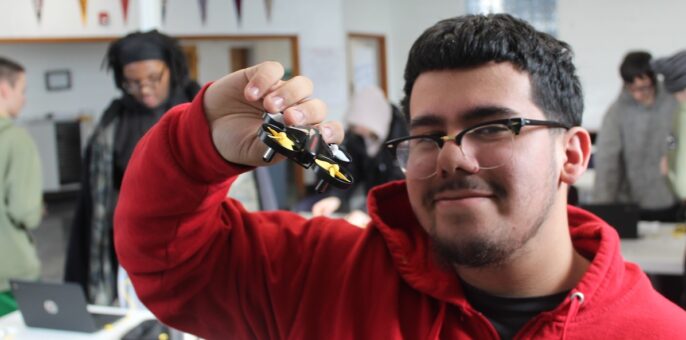Despite their long history, I have often wondered whether conventional school districts can truly evolve to meet the needs of today’s learners. And the truth is there are plenty of recent examples to suggest that, in fact, districts may be on their last legs.
“Urban school districts are in crisis,” wrote the Hechinger Report just last year. “Student and teacher absenteeism, special education referrals, mental health complications and violence within and outside schools are all on the rise as student enrollment and state funding are in free fall. Morale is low for teachers, principals and district leaders, so much so that as one superintendent put it, “This job is becoming unsustainable for people to be able to have a healthy life.”
You can imagine my surprise, then, when I visited a textbook example of a conventional school district—Liberty Public Schools, in Liberty, Missouri—and discovered that many of its most timeworn features are actually driving the change, not preventing it.
How is Liberty pulling this off—and what can the rest of America’s school districts learn from their example?
First, let’s run the numbers.
Liberty Public Schools is responsible for educating 12,000 students PreK–12, across eleven elementary schools, four middle schools, two comprehensive high schools, one alternative high school, and one early childhood center. The district covers 85 square miles, has 340 daily bus routes, runs a $280 million budget, and employs more than 2,000 staff members. The average teacher makes $68,900, while educating the average student costs a shade below $15,000 per year.
Like I said—textbook.
Spend some time in Liberty’s schools, however, and you’ll realize that they’re made up of leaders who are doing two seemingly contradictory things at once: leveraging the centralizing power of the district model, and decentralizing authority over who gets to discover the best new ways to engage young people in their learning.
For the first part of the equation, consider the district’s two comprehensive high schools, Liberty High and Liberty North, which, in their Rushmorean scale of curricular offerings, are enticing every kid to unleash their inner Max Fischer.
Indeed, although we talk a lot these days about the need to make the city the school, in a place like Liberty North, the school is the city—complete with a cornucopia of programs, spaces, and mentors for motivated kids to choose from.
One of them is Ava, a tall, composed senior who had clearly spent the previous four years immersing herself in her school’s theater program (complete with a thousand-seat performance space), its commercial-grade kitchen and production studio, and everything in between. “I’ve been given a lot of opportunities here,” she said as she toured us through her school’s cavernous hallways. “And I’ve taken a lot.”
Such a confession is music to the ears of the school’s principal, Rosemary Camp. “The things we take pride in are creating opportunities for students to thrive,” she told me, “and so we’ve been intentional about giving learners the autonomy and the ownership to chart their own course.”
There are too many examples of this to list, but here are a few: As part of an initiative called Network 53, career navigators float between the district’s high schools to facilitate career-minded learning opportunities and place kids at internships that can last anywhere between a semester or a full year. Each of the main high schools has its own microschool, housed in its own wing, with garage doors, bright colors, and open studios—making it feel more like a tech campus than a conventional high school. And the district aspires to ensure that every Liberty student graduates with at least one Market-Valued Asset, an industry-recognized credential of one form or another that, as Superintendent Jeremy Tucker says, “will make them more likely to enroll in postsecondary education and navigate the journey from school to employment with greater intention and success.”
“We are constantly ideating here,” Tucker continued. “We don’t want to be an island, but a lighthouse.”
The things we take pride in are creating opportunities for students to thrive, and so we’ve been intentional about giving learners the autonomy and the ownership to chart their own course.
Rosemary Camp
Of course, the reality is that while students like Ava will find a way to take advantage of everything a comprehensive high school has to offer, other students will just as surely struggle to find their footing.
For them, the district’s alternative high school, Liberty Academy, is a godsend.
It serves just a hundred students, in a shuttered commercial space that has been reimagined as a sprawling living room—filled with photos and enticing arrangements of furniture that are designed for connection, not efficiency. The school organizes 30-35 off site trips per week, all customized to student interest and skill preference. As Director Melissa Norris puts it, “At Liberty Academy, our students don’t have classrooms, our teachers don’t have desks, and our schedule is subject-free and flexible to the hour. Our school isn’t designed to help students prepare for specific careers; it’s designed to help them figure out what comes next as a result of the things they’re learning about themselves.”
“A lot of our kids are hurting,” she continues. “We tell them your job is to work on you. What are your strengths and passions? How can you match them to meet the needs of the world? Content is not the main character here. Relationships and autonomy are. That’s our recipe. And we’ve always had power and authenticity within the larger system. We’re allowed to think big.”
The day I’m there, staff are meeting individually with each senior to review all of their work and talk about their plans after graduation. A young girl with magenta hair talks about what she’s been reading, reflecting on its story of addiction and how it reminds her of a friend she lost to an overdose. “His addiction was even worse than mine,” she offers while fidgeting with the holes in her jeans. “Looking back on my personal growth, it’s amazing to see how far I’ve come. There was a time when I was overwhelmed by anger and fear. But I’ve learned how to step back, reflect, and approach situations with a clearer perspective.”
At the younger grades, Liberty is equally diverse in its learning settings. At one of its elementary schools, for example, children are organized by large studios—50 students each—instead of classrooms. Learners cycle through different age-based curricula that prepare them to be Builders, then Leaders, and then Designers. “At the beginning of my career,” said the school’s principal, Jamie Ackart, “like a lot of educators, I thought I was the main character. Now I know my job is just to lift the curtain. The district trusts us to do that. We know we need to be in a constant state of reinvention.”
Of course, that spirit can’t merely reside in a district’s individual schools; it must permeate through, and flow from, the central office. And “rather than scaling a program,” Tucker explained, “LPS is scaling a mindset.”
Liberty’s Head of Innovation, Julie Moore, agreed. “I’ve worked in different districts over the course of my thirty-year career,” she explained. “This is the only one where risk-taking was genuinely accepted. And the reality is, there are some good features to a district’s conventional structures. They keep us grounded in academic rigor. Our local property taxes give us the financial support we need to try new things. And we can offer kids the greatest possible variety of programs and experiences. The key is keeping those systems refreshed.”
That drive to revisit and refresh is what led Liberty to join Education Reimagined’s national cohort of twelve communities that are working to establish true learner-centered ecosystems—as the only conventional district in the bunch. “Nature shows us that growth comes from disequilibrium,” Moore said. “And although we can still get in our own way, I don’t think we’ve ever approached change by saying we can’t do something because of some legacy structure. We want our kids to bob and weave—not be too rigid or too locked in too early.”
“Our task is to humanize humans,” Moore reflected. “And innovation isn’t a process; it’s an ecosystem.”
This article is part of a series highlighting sites from Education Reimagined’s Learner-Centered Ecosystem Lab. In collaboration with writer, filmmaker, and global design consultant Sam Chaltain, Education Reimagined is showcasing the development of learner-centered ecosystems in communities across the United States.




